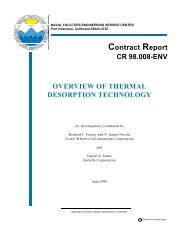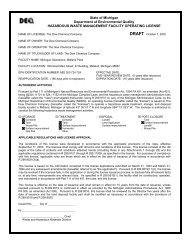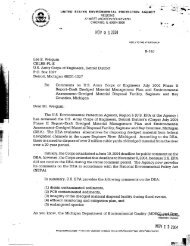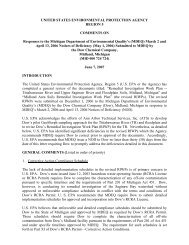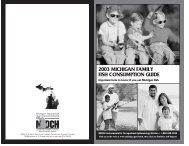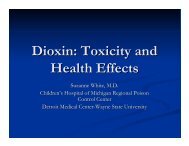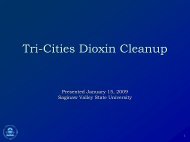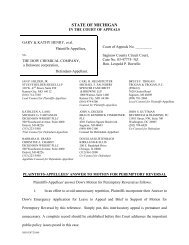Tittabawassee River and Flood Plain SOW - State of Michigan
Tittabawassee River and Flood Plain SOW - State of Michigan
Tittabawassee River and Flood Plain SOW - State of Michigan
Create successful ePaper yourself
Turn your PDF publications into a flip-book with our unique Google optimized e-Paper software.
. Definition <strong>of</strong> less than 100 year <strong>Flood</strong>plain areas (e.g. 1 yr, 5 yr, 25 yr, 50yr<br />
floodplain areas);<br />
c. Monthly temperature averages <strong>and</strong> extremes;<br />
d. Wind speed <strong>and</strong> direction; <strong>and</strong><br />
e. Evaporation data.<br />
B. Evaluation <strong>of</strong> the Potential for Continuing Sources:<br />
The RI will include an evaluation <strong>of</strong> whether there are any continuing sources <strong>of</strong><br />
chemicals <strong>of</strong> concern in the <strong>Tittabawassee</strong> <strong>River</strong> sediments by reviewing the<br />
information collected under subtask IV. A., IV.C. <strong>and</strong> IV.D. The RI will coordinate<br />
with License Condition X.M - Surface Water Monitoring Program, under which Dow<br />
will implement a program to monitor surface water to determine if the Dow facility is<br />
a source <strong>of</strong> chemicals <strong>of</strong> concern to the <strong>Tittabawassee</strong> <strong>River</strong>. If continuing sources<br />
are identified they will be characterized as follows:<br />
1. Location <strong>of</strong> source area; <strong>and</strong><br />
2. Known information on nature <strong>and</strong> extent <strong>of</strong> source area.<br />
C. Characterization <strong>of</strong> <strong>Tittabawassee</strong> <strong>River</strong> Sediments <strong>and</strong> <strong>Flood</strong>plain Soils, fish <strong>and</strong><br />
wildlife:<br />
The RI will collect analytical data on soils, surface water, <strong>and</strong> sediment, as<br />
appropriate, in the <strong>Tittabawassee</strong> <strong>River</strong> <strong>and</strong> <strong>Flood</strong>plain. The RI will also collect <strong>and</strong><br />
analyze fish <strong>and</strong> other wildlife that live in <strong>Tittabawassee</strong> <strong>River</strong> <strong>and</strong> on the <strong>Flood</strong>plain.<br />
These data shall be sufficient to define the concentrations <strong>of</strong> chemicals <strong>of</strong> concern in<br />
the study area.<br />
1. Statistical Sampling <strong>of</strong> Sediments <strong>and</strong> <strong>Flood</strong>plain Soils:<br />
a. Based on the Data Gap analysis (Task II.C.), locations for sampling will be<br />
identified <strong>and</strong> sampling will be conducted <strong>of</strong> sediments or soils;<br />
b. A statistical sampling approach will be applied;<br />
c. The approach chosen will result in a sampling plan that will characterize the<br />
concentration <strong>of</strong> chemicals <strong>of</strong> concern in the <strong>Tittabawassee</strong> <strong>River</strong> sediments<br />
<strong>and</strong> <strong>Flood</strong>plain soils; <strong>and</strong><br />
d. Further characterization <strong>and</strong> evaluation <strong>of</strong> sediment layers relative to<br />
chemicals <strong>of</strong> concern concentrations, deposition rates relative to geologic<br />
11



